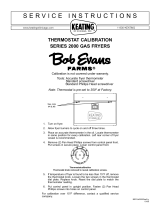
Table of Contents (Service)
Section Title Page
Table of Contents (Service).
.....................................................................………………………................
List of Figures .....................................................................................................................…..…………………………ii
Chapter 4: Service .................................................................................................................………………………..4-1
4.1 REPLACEMENT PROCEDURES.........................................................................……………….………………4-1
4.1.1 Heating Element Removal and Replacement.................................................…………………………….4-1
4.1.2 Backup Thermostat Replacement - Computer Models Only...........................…………………………...4-2
4.1.3 Calibrating the Thermostat - Computer Models Only....................................……………………………4-3
4.2 TESTING CONTACTORS (RELAYS)..............................................................……………………..….4-3
4.3 TESTING HEATING ELEMENTS ....................................................................…………………….….4-4
4.4 TESTING THE TEMPERATURE SETTING POTENTIOMETERS .................…………………….…4-4
4.5 TESTING THE TEMPERATURE CONTROL MODULES .............................……………………..….4-4
4.6 TESTING THE TEMPERATURE PROBE.......................................................……………………...….4-5
4.7 TESTING THE HEATING ELEMENT INTERLOCK......................................……………………..….4-5
4.8 TROUBLESHOOTING FRYERS WITHOUT COMPUTERS...........................………………………..4-7
4.9 TROUBLESHOOTING FRYERS WITH COMPUTERS................................……………………..….4-14
4.10 TROUBLESHOOTING BASKET LIFT PROBLEMS ......................................……………………....4-16
4.11 TROUBLESHOOTING BUILT-IN FILTER UNITS ...........................................…………………..…4-18
4.12 TROUBLESHOOTING UFM FILTER UNITS .................................................……………………….4-21
Chapters: Parts ..................................................................................................................……………………….….5-1
Fig. No.
5-1 Outside View ........................................................................................................……………………….5-2
5-2 Entrance Box .........................................................................................................………………………5-3
5-3 Inside Fryer Tank Components ...............................................................................……………………..5-4
5-4 Frame-Cabinet / Electrical Assemblies With Components .....................................……………………..5-7
5-5 UFM Filter, Frame/Electrical Assembly .................................................................……………………..5-9
5-6 UFM Filter, Pick-Up/Pan Assembly .....................................................................………………………5-11
5-7 UFM Filter, Motor / Return Assembly...............................................................………………………...5-13
5-8 Built-in Filter Pan With Components...................................................................……………………….5-15
5-9 Filter Piping With Components.........................................................................………………………....5-17
5-10 Built-in Filter With Accessories........................................................................………………………....5-19
ALPHABETICAL PART LIST .........................................................................………………………..5-20
NUMERICAL PART LIST................................................................................………………………..5-24
i























